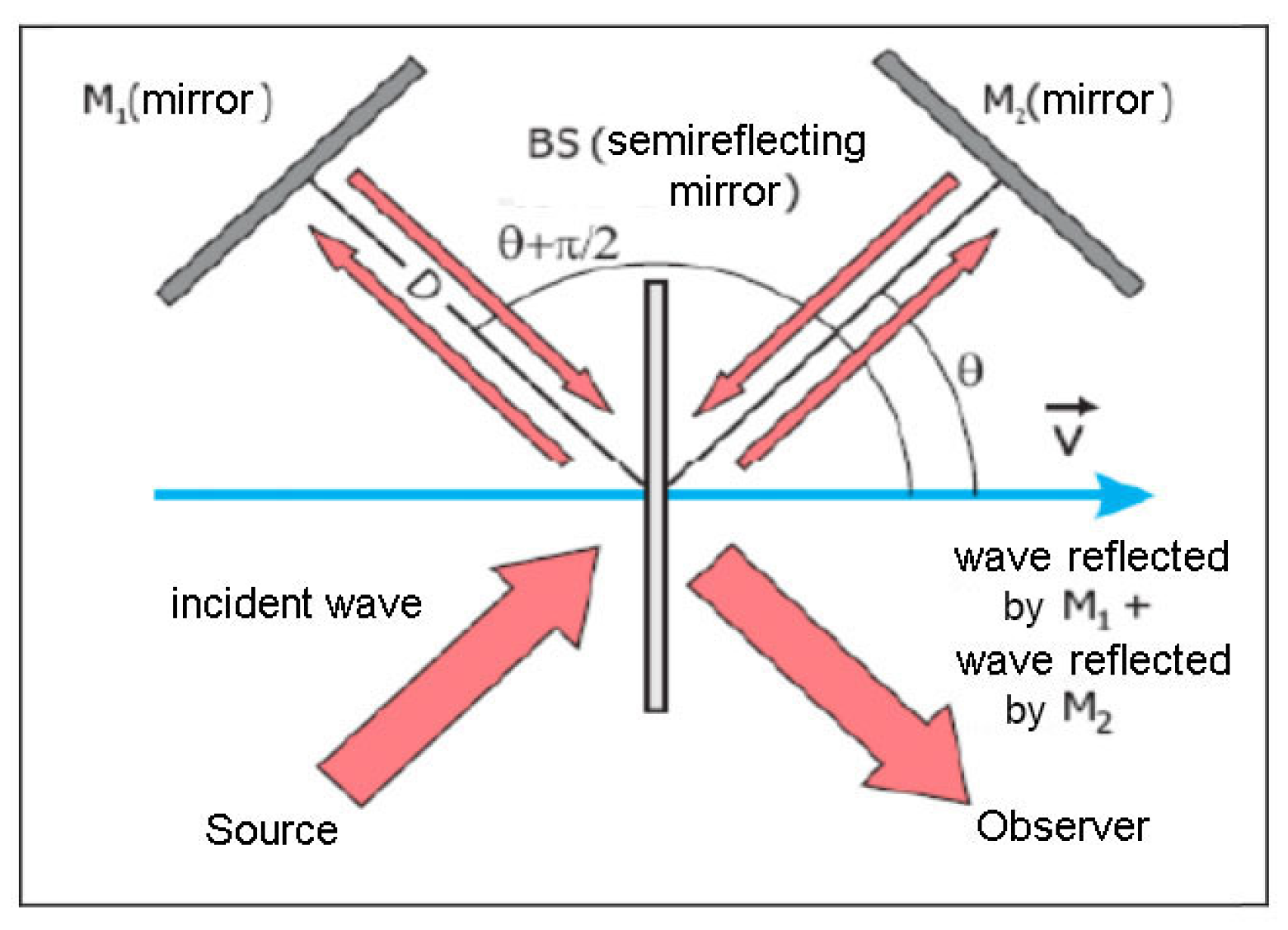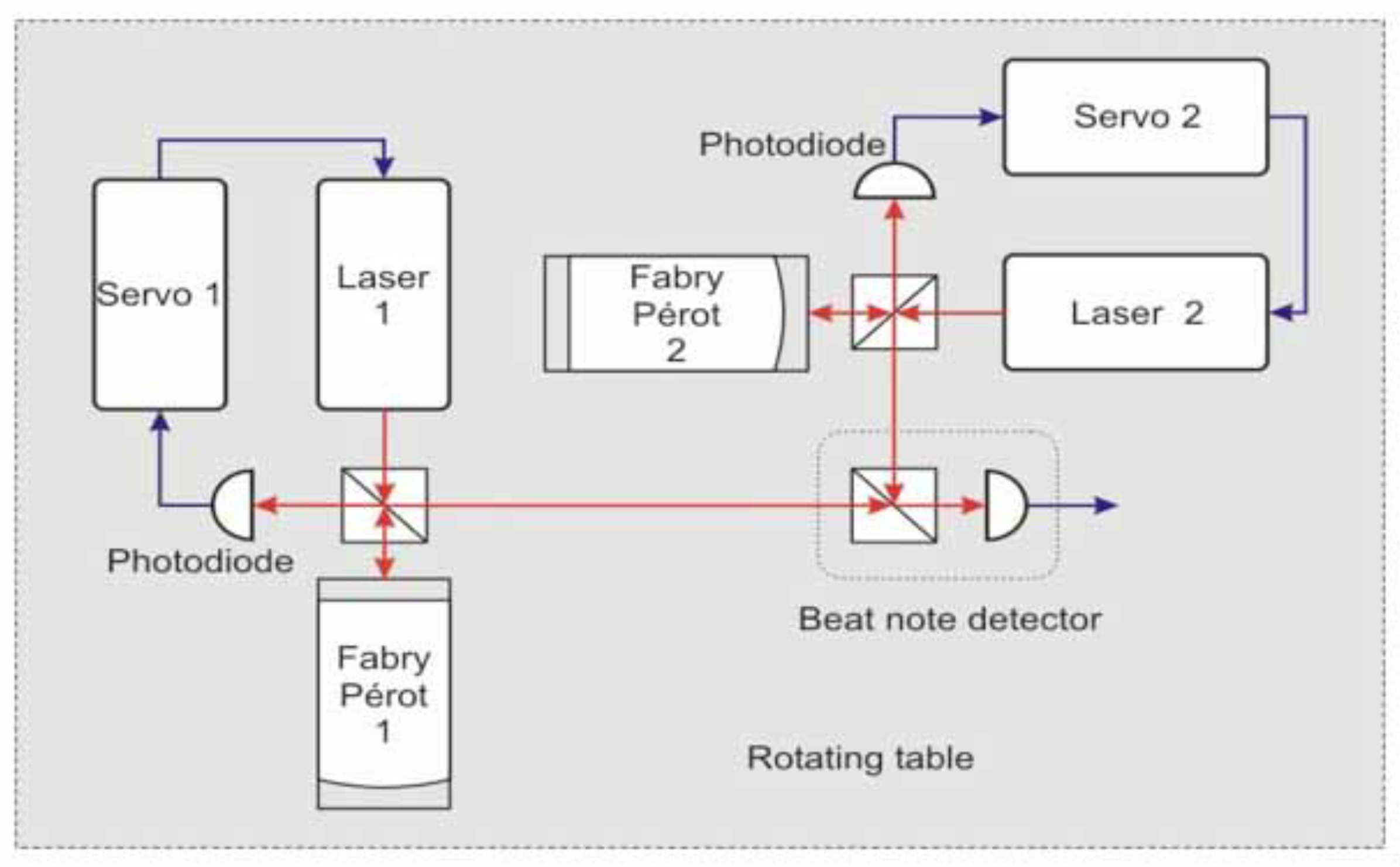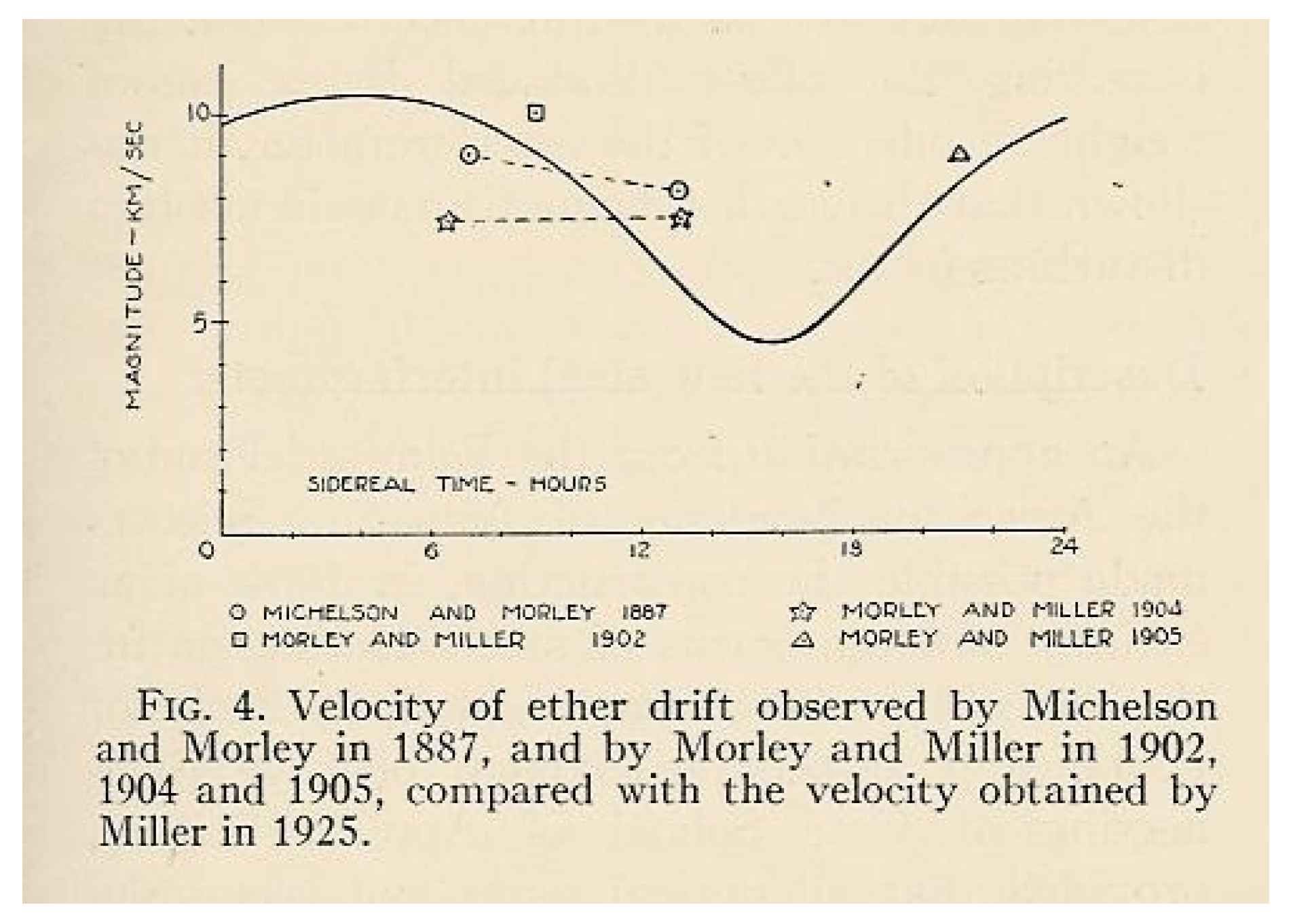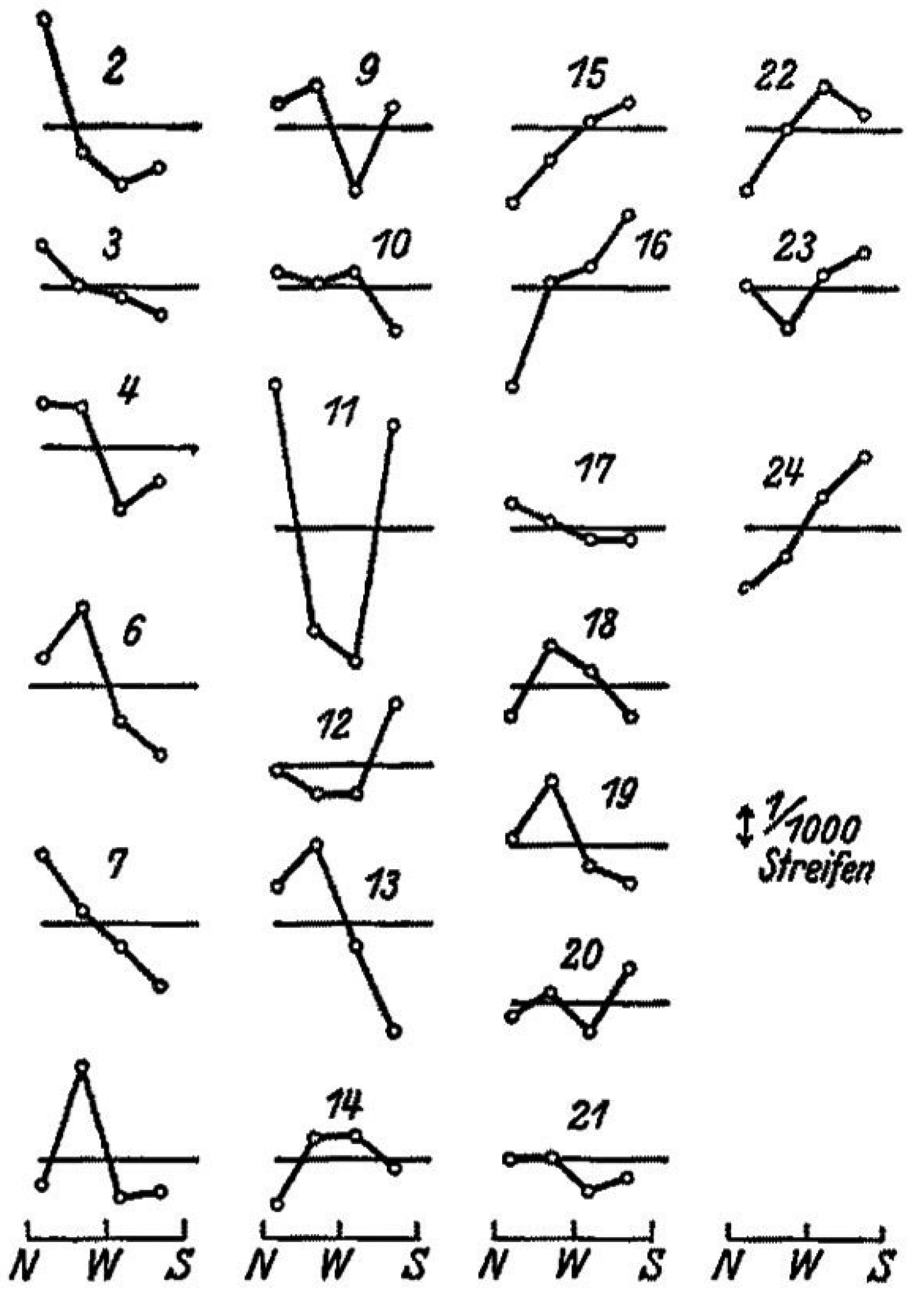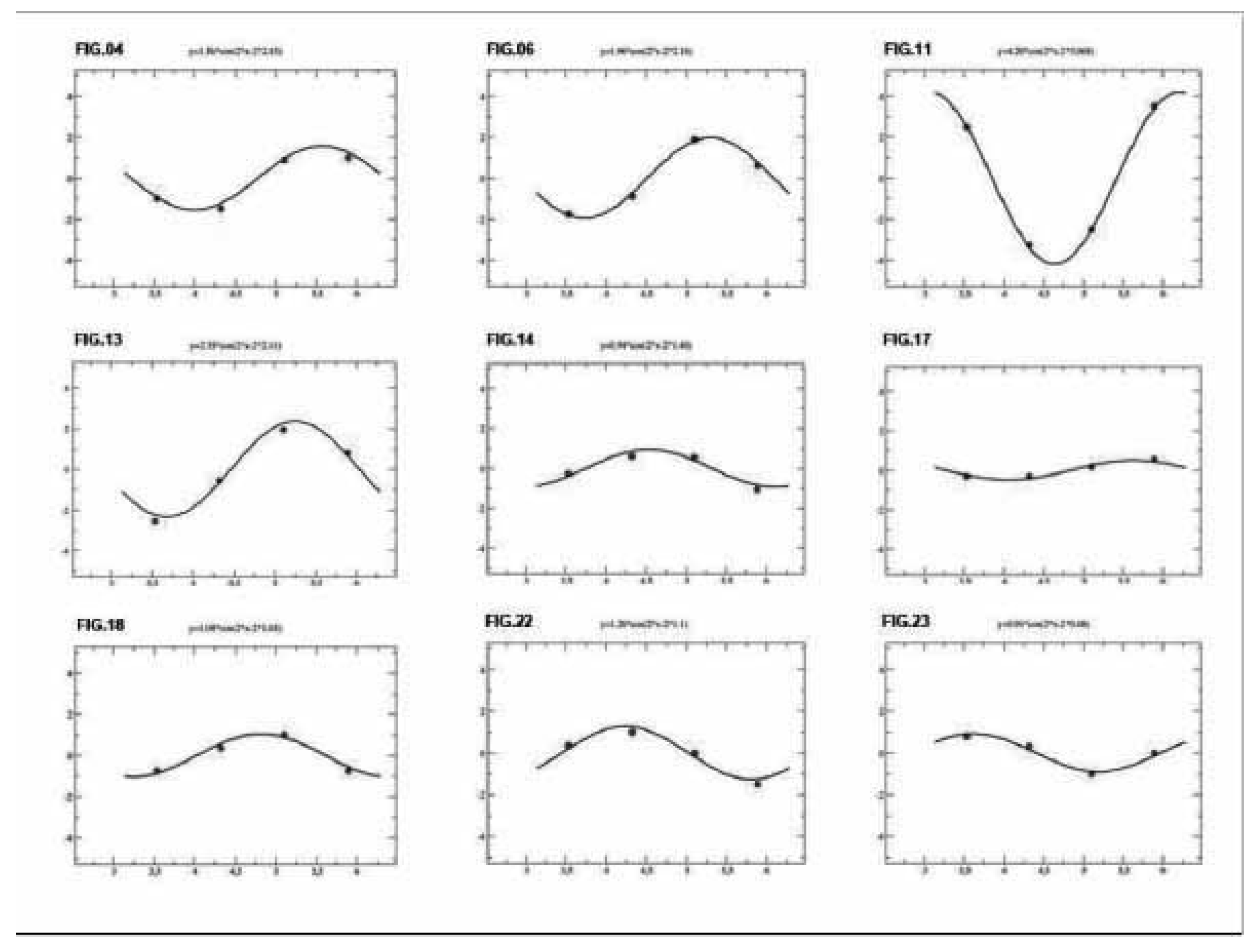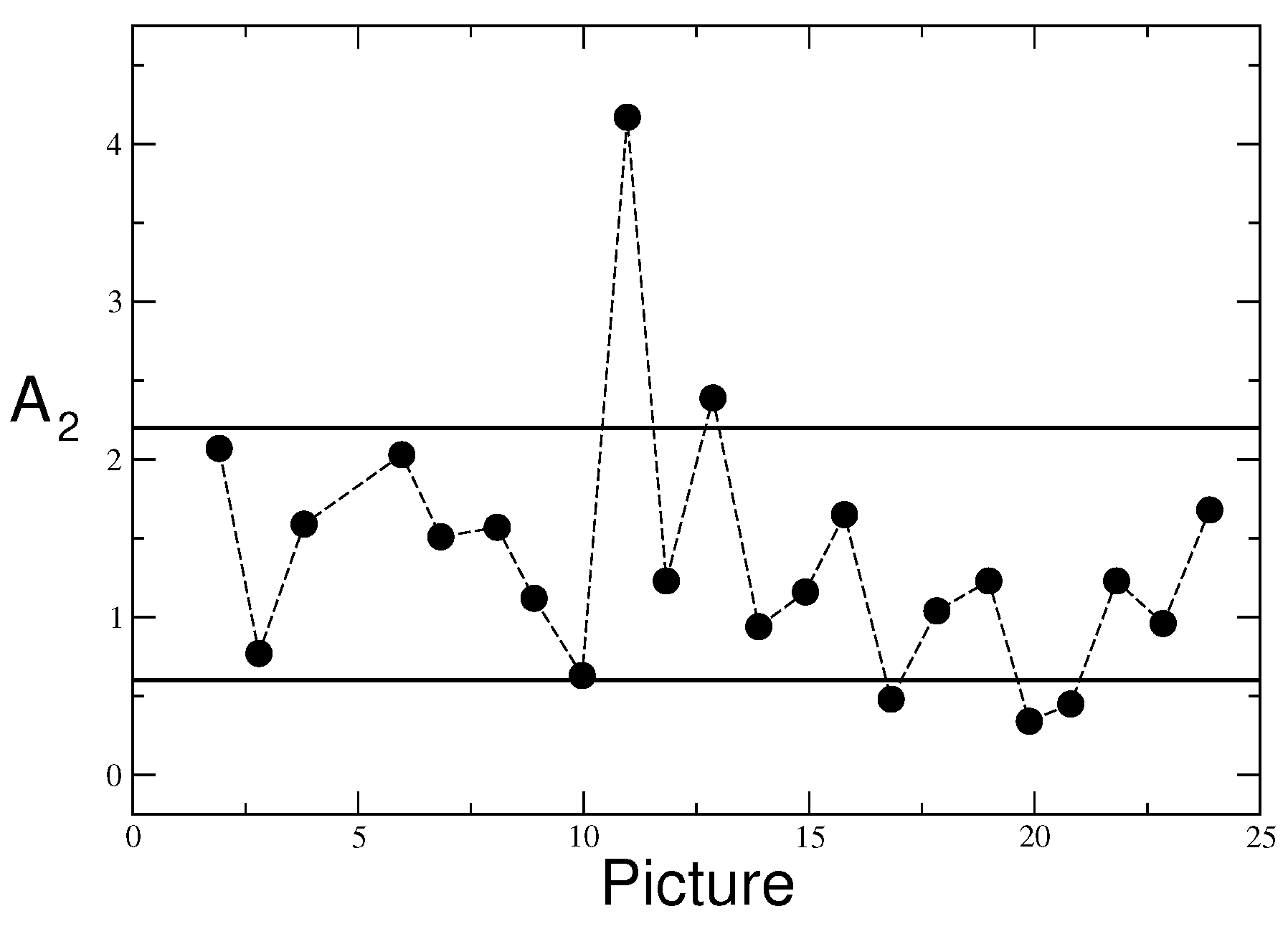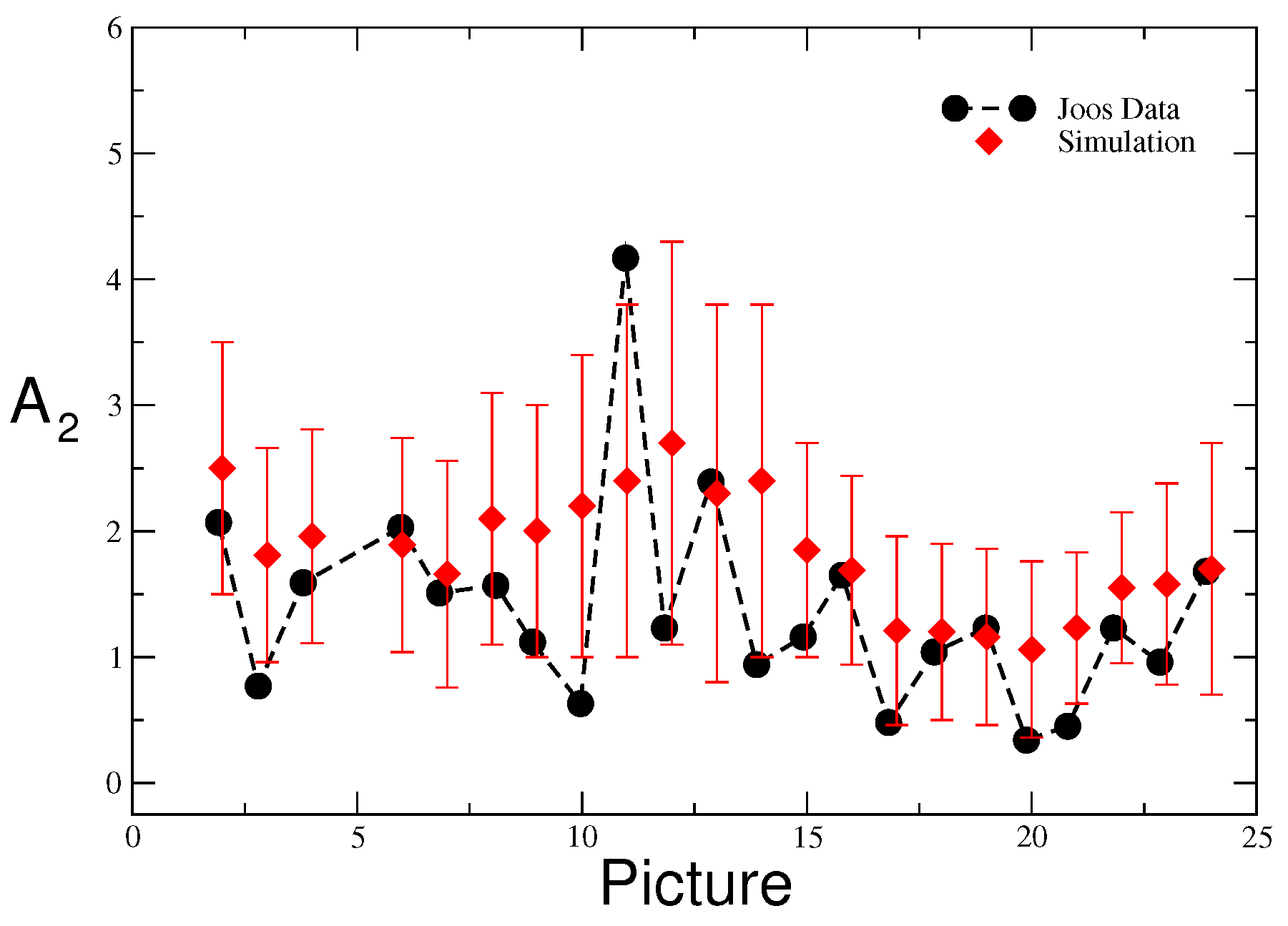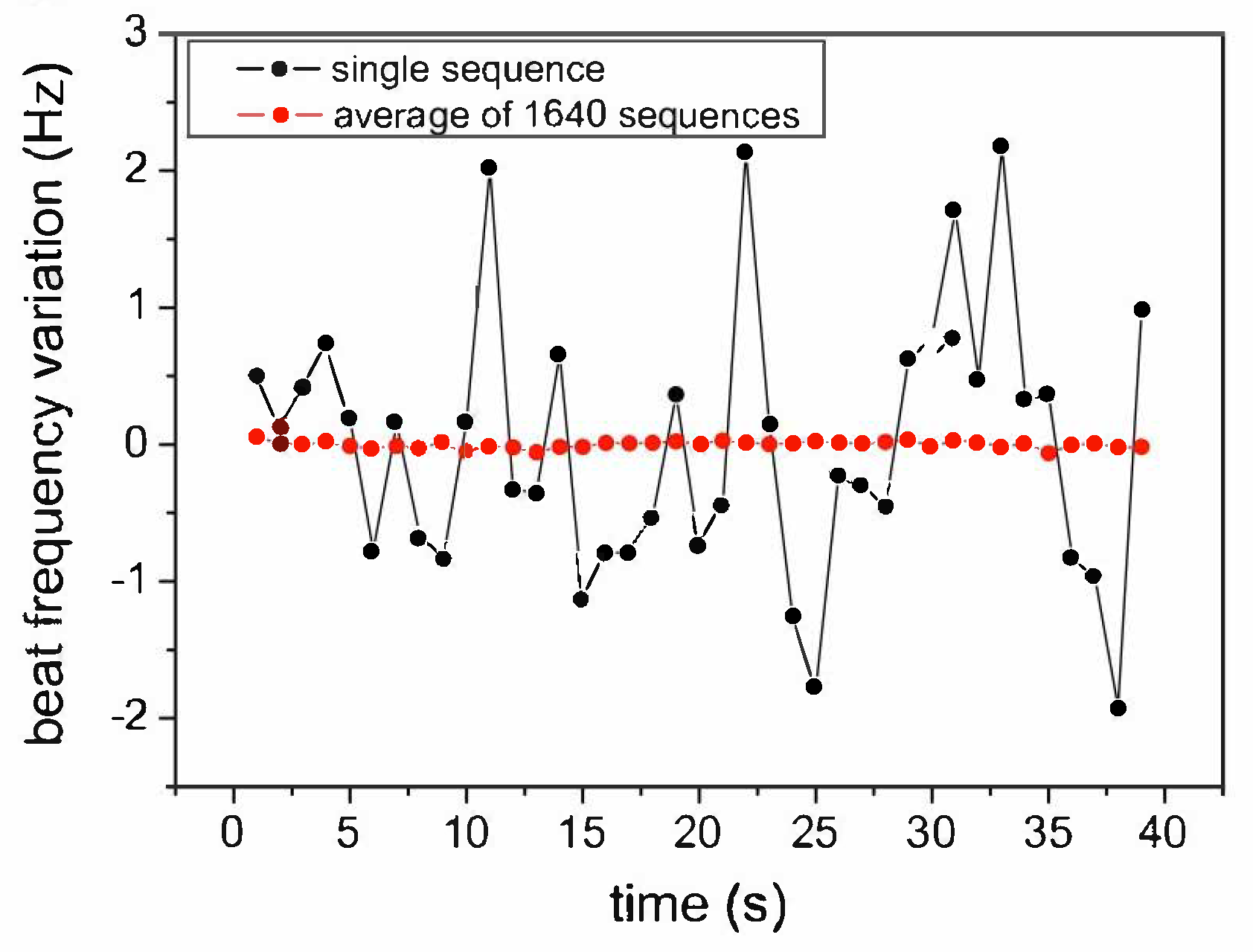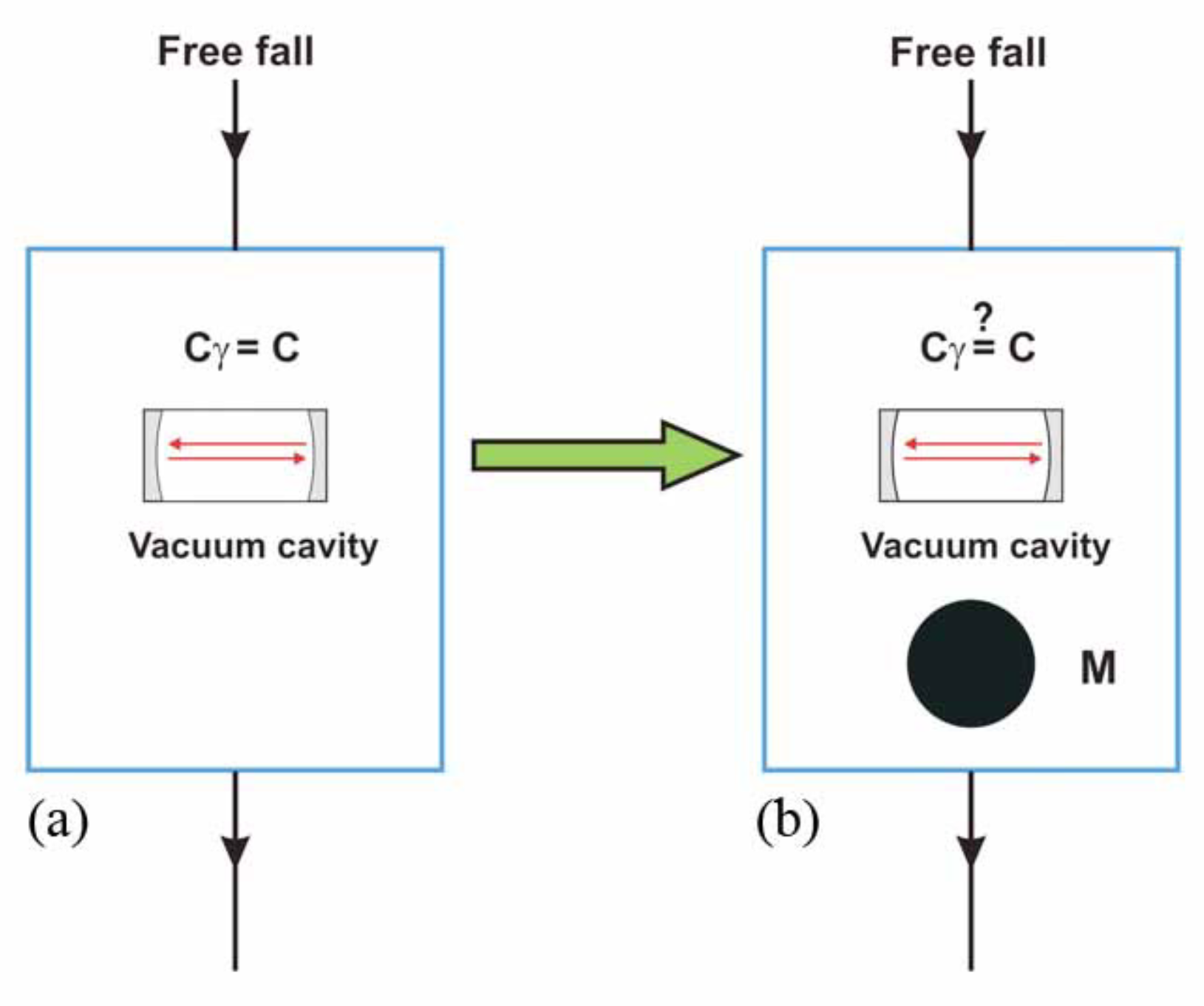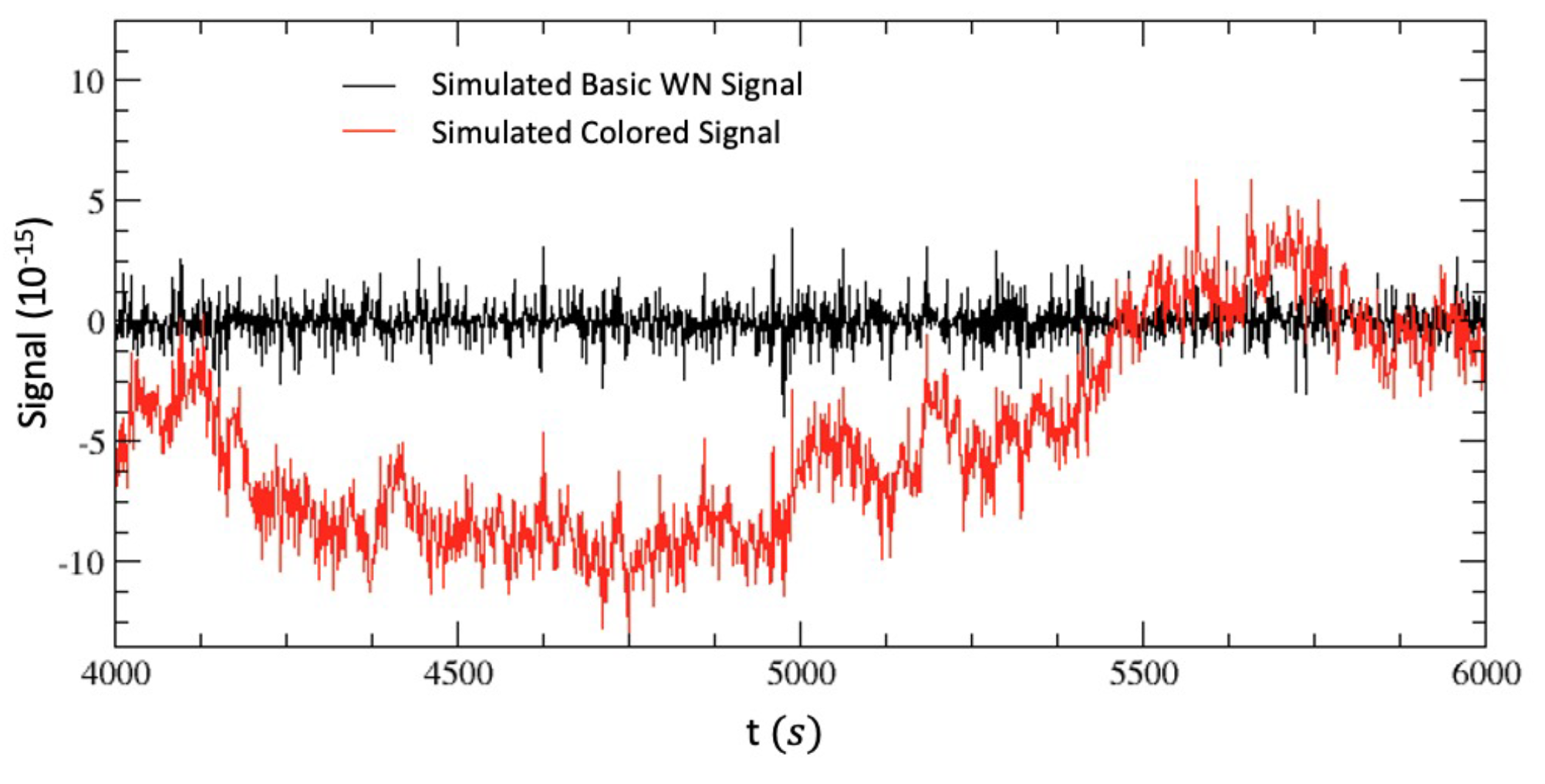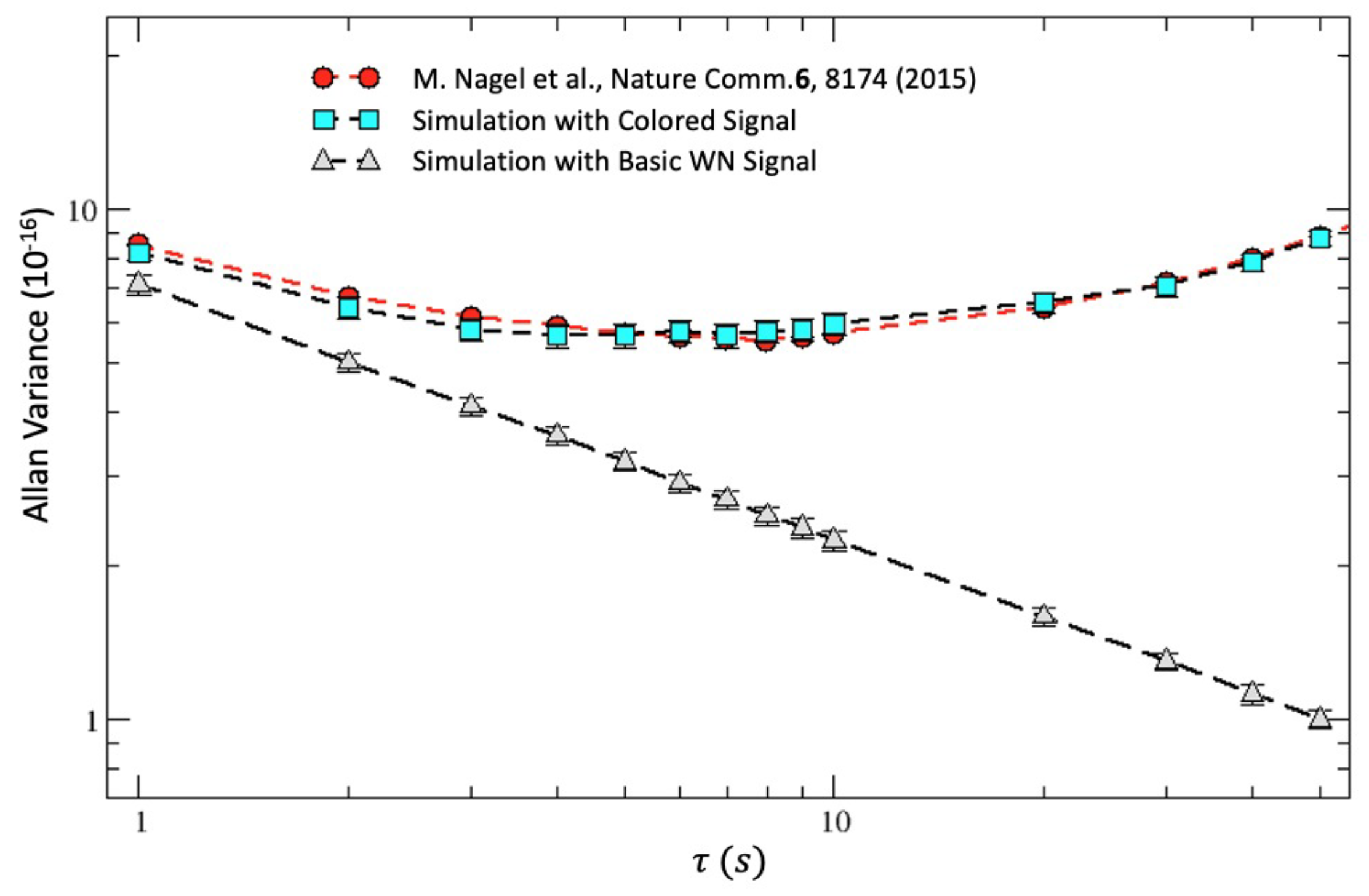1. Introduction
Soon after the discovery [
1] of the Cosmic Microwave Background (CMB), it was realized that the observed temperature of the radiation should exhibit a small anisotropy as a consequence of the Doppler effect associated with the motion of the Earth [
2,
3] (
:
Accurate observations with satellites in space [
4,
5] have shown that the measured temperature variations correspond to a motion of the solar system described by an average velocity
km/s, a right ascension
, and a declination
, pointing approximately in the direction of the constellation Leo. This means that, if one sets
2.725 K and
, there are angular variations of a few millikelvin:
These variations represent by far the largest contributions to the CMB anisotropy and are usually denoted as the
kinematic dipole [
6].
With this interpretation, it is natural to wonder about the reference frame in which this CMB dipole vanishes exactly, i.e., could it represent a fundamental system for relativity, as in the original Lorentzian formulation? The standard answer is that one should not confuse these two concepts. The CMB is a definite medium and sets a rest frame where the dipole anisotropy is zero. There is nothing strange in that our motion with respect to this system can be detected. In this sense, there would be no contradiction with special relativity.
However, to a good approximation, this kinematic dipole arises from the vector combination of the various forms of peculiar motion that are involved (rotation of the solar system around the center of the Milky Way, motion of the Milky Way toward the center of the Local Group, motion of the Local Group of galaxies in the direction of the Great Attractor, etc.) [
5]. Therefore, since the observed CMB dipole reflects local inhomogeneities, it becomes natural to imagine a global frame of rest associated with the Universe as a whole. The isotropy of the CMB could then just
indicate the existence of this fundamental system
that we may conventionally decide to call “ether”, but the cosmic radiation itself would not
coincide with this form of ether
1. Due to the group properties of Lorentz transformations, two observers S’ and S”, moving individually with respect to
, would still be connected by a Lorentz transformation with a relative velocity parameter fixed by the standard relativistic composition rule
2. However, the ultimate consequences could be far reaching, even considering just the implications for the interpretation of non-locality in the quantum theory
3.
The idea of a preferred frame finds further motivation in the modern picture of the vacuum, which is intended as the lowest-energy state of the theory. This is not trivial emptiness, but is believed to arise from the macroscopic Bose condensation process of Higgs quanta, quark-antiquark pairs, gluons, etc.; see, e.g., [
15,
16,
17,
18,
19]. The hypothetical global frame could then reflect a vacuum structure that has a certain substantiality and can determine the type of relativity physically realized in nature.
Since the answer cannot be found with theoretical arguments only, the physical role of is thus traditionally postponed to the experimental observation, in the Earth frame , of some dragging of light: the effect of an “ether drift”. This would require: (i) the detection of a small angular dependence of the two-way velocity of light in the laboratory and (ii) the correlation this angular dependence with the direct CMB observations with satellites in space.
Of course, experimental evidence for both the undulatory and corpuscular aspects of radiation has substantially modified the consideration of an ether and its logical need for the physical theory. However, the existence of a rest frame that is tight with respect to the underlying energy structure of the vacuum does not contradict the basic tenets of general relativity, where the off-diagonal components
of the metric play the role of a velocity field and, as such, are the most natural way to introduce effects associated with the state of motion of the observer, such as, for instance, a small angular dependence of the velocity of light
4.
So far, it is generally believed that no genuine ether drift has ever been observed. In this traditional view, which dates back to the end of 19th century, when one was still comparing with Maxwell’s classical predictions for the orbital velocity
30 km/s, all measurements (from Michelson–Morley to the most recent experiments with optical resonators) are seen as a long sequence of null results, i.e., typical instrumental effects in experiments with better and better systematics (see, e.g., Figure 1 of Ref. [
25]).
However, upon closer inspection, things are not so simple for at least three reasons:
(i) In the old experiments (Michelson–Morley, Miller, Tomaschek, Kennedy, Illingworth, Piccard–Stahel, Michelson–Pease–Pearson, Joos) [
26,
27,
28,
29,
30,
31,
32,
33,
34,
35], light was propagating in gaseous media, air, or helium at room temperature and atmospheric pressure. In these systems with a refractive index of
, the velocity of light in the interferometers, say
, is not the same parameter
c of Lorentz transformations. Hence, nothing prevents a non-zero effect because, when light is absorbed and re-emitted, the small fraction of refracted light could keep track of the velocity of matter with respect to the hypothetical
and produce a direction-dependent refractive index. Then, from symmetry arguments valid in the
limit [
36,
37,
38,
39,
40], one would expect
, which is much smaller than the classical expectation
. For instance, in the old experiments in air (at room temperature and atmospheric pressure, where
), a typical value was
. This was classically interpreted as a velocity of 7.3 km/s, but would now correspond to 310 km/s. Analogously, in the old experiment in gaseous helium (at room temperature and atmospheric pressure, where
), a typical value was
. This was classically interpreted as a velocity of 2 km/s, but would now correspond to 240 km/s. Those old measurements could thus become consistent with the motion of the Earth in the CMB.
(ii) Differently from those old measurements, in modern experiments, light now propagates in a high vacuum or in solid dielectrics, often in the cryogenic regime. Then, the more stringent limits of the present might not depend only on the technological progress, but also on the media that are tested, thus preventing a straightforward comparison.
(iii) In the analysis of the data, the hypothetical signal of the drift was always assumed to be a
regular phenomenon—namely, with only smooth time modulations that depend deterministically on the rotation of the Earth (and its orbital revolution). The data, instead, always had an irregular behavior, with statistical averages much smaller than the individual measurements, inducing one to interpret the measurements as typical instrumental artifacts. However, a relation, if any, between the macroscopic motion of the Earth and the microscopic propagation of light in the laboratory depends ultimately on the nature of the physical vacuum. By comparing with the motion of a body in a fluid, this traditional view corresponds to the form of regular (“laminar”) flow in which global and local velocity fields coincide. Some general arguments (see [
41,
42]) suggest instead that the physical vacuum might behave as a stochastic medium that resembles a turbulent fluid in which large-scale and small-scale flows are only
indirectly related. This means that the projection of the global velocity field at the site of the experiment, say
, could differ non-trivially from the local field
, which determines the direction and magnitude of the drift in the plane of the interferometer. In particular, if turbulence becomes isotropic at the small scale of the experiment, a genuine non-zero signal can coexist with vanishing statistical averages for all vector quantities. Thus, one should Fourier analyze the data for
and extract the (second-harmonic) phase
and amplitude
, which give, respectively, the direction and magnitude of the local drift, and concentrate on the amplitude, which, being positive definite, remains non-zero under any averaging procedure. By correlating the local
with the global
, the time modulations of the statistical average
will then give information on the magnitude, right ascension, and declination of the cosmic motion. Depending on the type of correlation, there are various implications. For instance, in a uniform-probability model, where the kinematic parameters of the global
are just used to fix the typical boundaries for a local random
, one finds
, where
is the amplitude in the deterministic picture. With such smaller statistical averages, one will obtain a velocity that is larger by
1.35 from the same data. Therefore, by returning to those old measurements—
and
, respectively, for air or gaseous helium at atmospheric pressure—the data can be interpreted in three different ways: (a) as 7.3 and 2 km/s in a classical picture, (b) as 310 and 240 km/s in a modern scheme and in a smooth picture of the drift, or (c) as 418 and 324 km/s in a modern scheme, but now allowing for irregular fluctuations of the signal. In this third interpretation, the average of the two values agrees very well with the CMB velocity of 370 km/s.
After having illustrated why the evidences for
may be much more subtle than usually believed, in
Section 2, we will review the basics of these experiments and, in
Section 3 and
Section 4, we will review the alternative theoretical framework of [
37,
38,
39,
40]. This will be applied in
Section 5 to the old experiments in gaseous media, where
was extracted from the fringe shifts in Michelson interferometers. As we will show, our scheme leads to a consistent description of the data and to remarkable correlations with the direct CMB observations with satellites in space.
Still, the simple relation
leaves unexplained the physical mechanisms producing the observed anisotropy in gaseous systems. As a first possibility, we have thus considered that the electromagnetic field of the incoming light could determine different polarizations in different directions in the dielectric depending on its state of motion. However, if this works in weakly bound gaseous matter, the same mechanism should also work in a strongly bound solid dielectric, where the refractivity is
, and thus, it should produce a much larger
. This is in contrast with the Shamir–Fox [
43] experiment in perspex, where the observed value was smaller by orders of magnitude. Then, as an alternative possibility, in
Section 6, we review the traditional thermal interpretation [
44,
45] of the residuals in gaseous media. The idea was that, in a weakly bound system as a gas, a small temperature difference
of a millikelvin or so between the optical arms could induce convective currents in the gas and, in turn, angular differences in the refractive index proportional to
, where
300 K is the temperature of the laboratory. In our scheme, the overall consistency of different experiments would now indicate that such
must have a
non-local origin as if the interactions with the background radiation could transfer a part of
in Equation (
2) and bring the gas out of equilibrium. However, those old estimates were slightly too large because our analysis gave
mK. Thus, these interactions were so weak that, on average, the temperature differences induced in the optical paths were only 1/10 of the
in Equation (
2). Nevertheless, whatever its precise value is, this typical magnitude can help with intuition. In fact, it can explain the quantitative reduction of the effect in the vacuum limit, where
and the qualitative difference with strongly bound solid dielectrics, and where such small temperature differences would mainly dissipate through heat conduction without producing any particle motion and directional refraction in the rest frame of the medium.
Most significantly, this thermal argument has an interesting predictive power. In fact, it implies that if some tiny fundamental signal were definitely detected in vacuum, then, with very precise measurements, the same signal should also show up in a solid dielectric where the non-local thermal gradient is ineffective. In
Section 7, this expectation will be compared with the modern experiments, where
is now extracted from the frequency shift of two optical resonators. Here, after the vector average of many observations, the present limit is a residual
. However, this just reflects the very irregular nature of the signal because its typical
magnitude has a value
, which is about 1000 times larger. This
magnitude is found with vacuum resonators [
46,
47,
48,
49,
50,
51] made of different materials and operating at room temperature and/or in the cryogenic regime, as well as in the most precise experiment ever performed in a solid dielectric [
25]. As such, it could hardly be interpreted as a spurious effect. In the same model discussed above, we are then led to the concept of a refractive index
for the physical vacuum, which is established in an apparatus placed on the Earth’s surface. This
should differ from unity at the
level in order to give
, and thus, it would fit with [
52], where a vacuum refractivity
was considered. Indeed, if the curvature observed in a gravitational field reflects local deformations of the physical space-time units, for an apparatus on the Earth’s surface, there might be a tiny refractivity
, where
is the Newton constant and
M and
R are the mass and radius of the Earth. This could make a difference with the ideal free-fall environment, which is always assumed to operationally define the parameter
c of Lorentz transformations in the presence of gravitational effects. Then, for a typical daily projection of 250 km/s
370 km/s and in the same uniform-probability model that was used successfully for the classical experiments, we would expect a fundamental signal with an average magnitude of
. This is a genuine signal, which would pose an intrinsic limitation to the precision of measurements and, according to our numerical simulations, can be approximated as white noise. Thus, it should be compared with the frequency shift of two optical resonators at the largest integration time (typically 1 s) where the pure white-noise branch is as small as possible, but other types of noise are not yet important.
As emphasized in the conclusive
Section 8, the consistency of this prediction with the most precise measurements in vacuum and solid dielectrics that operate at room temperature and in the cryogenic regime and the satisfactory description of the old experiments should therefore induce one to perform an ultimate experimental check: detecting the expected, periodic, and daily variations in the range
.
3. A Modern Version of Maxwell Calculation
For a quantitative analysis, let us consider a medium of refractive index
with
. This medium fills an optical cavity at rest in the laboratory
frame in motion with velocity
v with respect to
. If we assume (a) that
is isotropic when
and (b) that Lorentz transformations are valid, then any anisotropy in
should vanish identically either for
or for the ideal vacuum limit, i.e., when the velocity of light tends to the basic parameter
c of Lorentz transformations
5. Therefore, one can perform an expansion in powers of the two small parameters
and
. Since, by its definition,
is invariant under the replacement
and, at fixed
, is invariant when replacing
, the lowest non-trivial angular dependence is found to be
and can be expressed in the general form [
17,
18,
19]:
In the above relation, the invariance under is achieved by expanding in even-order Legendre polynomials with arbitrary coefficients . These coefficients vanish identically in Einstein’s special relativity with no preferred system, but should not vanish a priori in a “Lorentzian” formulation.
If we retain the first few
s as free parameters, Equation (
8) could already be useful for fitting experimental data. In any case, independently of their numerical values, one should appreciate the substantial difference introduced with respect to the classical prediction. As an example, by assuming, for simplicity,
300 km/s and
for air at room temperature and atmospheric pressure, we find the following difference:
This would be about three orders of magnitude smaller than the classical estimate
that would be expected from Maxwell’s calculation [
57] for the same
300 km/s. However, depending on the actual
s, Equation (
9) would also be about 10 ÷ 20 times smaller than the old standard value for the much lower orbital velocity
30 km/s:
For experiments in gaseous helium at room temperature and atmospheric pressure, where
, the equivalent of Equation (
9) would even be
times smaller than this old standard. The above elementary arguments suggest that the old ether-drift experiments in gaseous media might have been overlooked. So far, they have been considered as null results. However, this may just depend on a comparison with the wrong classical formula.
However, the dependence on the unknown
s is unpleasant because it prevents a straightforward comparison with the data. For this reason, according to other symmetry arguments [
37,
39,
40], we will further sharpen our analysis with another derivation of the
limit. This additional derivation makes use of the effective space-time metric
, which should be substituted into the relation
to describe light in a medium with refractive index
; see, e.g., [
58]. At the quantum level, this metric was derived by Jauch and Watson [
59] when quantizing the electromagnetic field in a dielectric. They realized that the formalism introduces a preferred reference system where the photon energy
does not depend on the angle
of light propagation. They observed that this is “usually taken as the system for which the medium is at rest”, a conclusion that is obvious in special relativity, where there is no preferred system, but it is less obvious in our case. We will therefore adapt their results and consider a different limit where the photon energy
is
—independent only when
both the medium and observer are at rest in some frame
.
To see how this works, we will consider two identical optical resonators—namely, resonator 1, which is at rest in
, and resonator 2, which is at rest in
. We will also introduce
to indicate the light 4-momentum for
in its cavity 1 and
to indicate the analogous 4-momentum of light for
in its cavity 2. Finally, we will denote by
the space-time metric used by
in the relation
and by
the metric that
adopts in the analogous relation
and that produces the isotropic velocity
.
We emphasize the peculiar view of special relativity where no observable difference can exist between and . In our perspective, instead, this physical equivalence is only assumed in the ideal vacuum limit. Indeed, as anticipated in the introduction, in the presence of matter, where light is absorbed and then re-emitted, the fraction of refracted light could keep track of the particular motion of matter with respect to and produce a .
By first considering the
limit, the frame-independence of the velocity of light requires one to impose
where
is the Minkowski tensor. This standard equality amounts to the introduction of a transformation matrix, say
, such that, for
,
This relation is strictly valid for
. However, by continuity, one is driven to conclude that an analogous relation between
and
should also hold in the
limit. The only subtlety is that relation (
13) does not uniquely fix
. In fact, it is fulfilled either by choosing the identity matrix, i.e.,
, or by choosing a Lorentz transformation, i.e.,
. It thus follows that
is a two-valued function when
.
This gives two possible solutions for the metric in
. In fact, when
is the identity matrix, we find
while, when
is a Lorentz transformation, we obtain
where
is the
4-velocity, and
with
. As a consequence, the equality
can only hold for
, i.e., for
when
.
Notice that by choosing the first solution
, which is implicitly assumed in special relativity to preserve isotropy in all reference frames, as well as for
, we are considering a transformation matrix
that is discontinuous for any
. In fact, it is the non-trivial peculiarity of Lorentz transformations to enforce Equation (
13) for
so that
, and the Minkowski metric, if valid in one frame, will then apply to all equivalent frames.
On the other hand, if one inserts
into the relation
, the photon energy
will now depend on the direction of propagation. This gives the one-way velocity
, which, to
and
, is
with a two-way combination:
This final form, which corresponds to the setting in Equation (
8) (
,
, and all
for
), could be considered the modern version of Maxwell’s calculation [
57] and will be adopted in the analysis of experiments near the
limit, as for gaseous systems.
For the sake of clarity, let us return to the definition of the gas refractive index
in Equation (
11). How is this quantity related to the experimental value
obtained from the two-way velocity measured in the Earth laboratory? This can be easily understood by first introducing an angle-dependent
through
with
and then defining the isotropic experimental value after an angular averaging—namely,
One could therefore obtain the unknown value (as if the cavity with the gas were at rest in ) from the experimental and v. As an example, the most precise determinations for air are at a level , say , for 589 nm, 0 C, and atmospheric pressure. Therefore, for 370 km/s, the difference between and is smaller than and can be ignored. Analogous considerations apply to other gaseous media (such as N, CO, helium, etc.) where the precision in is, at best, at the level of a few . Finally, whatever v is, the relation becomes more and more accurate in the low-pressure limit where .
To conclude, from Equation (
17), the fractional anisotropy is found to be
and is suppressed by the small factor
with respect to the classical estimate
. Here,
v and
indicate the magnitude and the direction of the drift in the interferometer’s plane, and, from Equation (
5), one obtains the fringe pattern
In this way, the dragging of light in the Earth frame is described as a pure second-harmonic effect that is periodic in the range
. This is the same as in the classical theory (see, e.g., [
60]), with the exception of its amplitude,
which is suppressed by the factor
relative to the classical amplitude
. This difference could then be re-absorbed into an
observable velocity,
which depends on the gas refractive index
This
is the very small velocity traditionally extracted from the classical analysis of the experiments through the relation
when one was still comparing with the standard classical prediction
for the orbital velocity.
However, before a more detailed comparison with experiments, additional considerations are needed about the physical nature of the ether drift as an irregular phenomenon. Some general motivations and a simple stochastic model will be illustrated in the following section.
4. Dragging of Light as an Irregular Phenomenon
Aside from the magnitude of the signal, the other important aspect of the experiments concerns the time dependence of the data. As anticipated in the introduction, it was always assumed that, for short-term observations of a few days where there are no sizable changes in the orbital velocity of the Earth, a genuine physical signal should reproduce the regular modulations induced by its rotation. Instead, in both classical and modern experiments, the data have always shown a very irregular behavior with statistical averages that are much smaller than the instantaneous values. This was always a strong argument for interpreting the data as instrumental artifacts. However, in principle, a definite instantaneous value could also coexist with a vanishing statistical average.
This possibility was considered in [
37,
38,
39,
40,
41,
42] by assuming that the observed signal is determined by a local velocity field, say
, which does
not coincide with the projection of the global Earth motion, say
, at the observation site. By comparing with the motion of a body in a fluid, the equality
amounts to the assumption of a form of regular, laminar flow where global and local velocity fields coincide. Instead, in the case of a turbulent fluid, large-scale and small-scale flows would only be
indirectly related.
An intuitive motivation for this turbulent-fluid analogy derives from the comparison of the vacuum to a fluid with vanishing viscosity. Then, within the Navier-Stokes equation, a laminar flow is by no means obvious due to the subtlety of the zero-viscosity (or infinite Reynolds number) limit; see, for instance, the discussion given by Feynman in Section 41.5, Volume II of his Lectures [
61]. The reason is that the velocity of such a hypothetical fluid cannot be a differentiable function [
62], and one should think, instead, in terms of a continuous velocity field that is not differentiable anywhere [
63]. This analogy leads to the idea of a signal with a fundamental stochastic nature, such as when turbulence, at small scales, becomes homogeneous and isotropic.
With this in mind, let us return to Equation (
20) and make explicit the time dependence of the signal by re-writing it as
where
and
indicate, respectively, the
instantaneous magnitude and direction of the drift in the plane of the interferometer. This can also be re-written as
with
and
,
.
The standard analysis is based on a cosmic velocity of the Earth characterized by a magnitude
V, a right ascension
, and an angular declination
. These parameters can be considered constant for short-term observations of a few days so that, with the traditional identifications
and
, the only time dependence should be due to the Earth’s rotation. Here,
and
are derived from the simple application of spherical trigonometry [
64]:
In the above relations,
is the zenithal distance of
,
is the latitude of the laboratory,
is the sidereal time of the observation in degrees (
), and the angle
is counted conventionally from North through East so that North is
and East is
. With the identifications
and
(or, equivalently,
and
), one thus arrives at the simple Fourier decomposition
where the
and
Fourier coefficients depend on the three parameters
and are given explicitly in [
37,
40].
Instead, we will consider an alternative scenario where
and
. In particular, the local velocity components,
and
, will be assumed to be non-differentiable functions expressed in terms of random Fourier series [
62,
65,
66]. The simplest model corresponds to a turbulence, which, at small scales, appears homogeneous and isotropic. The analysis of the previous section can then be embodied in an effective space-time metric for light propagation
where
is a random 4-velocity field that describes the drift and whose boundaries depend on the smooth
determined by the average motion of the Earth. If this corresponds to the actual physical situation, a genuine stochastic signal can easily become consistent with average values
obtained by fitting the data with Equations (
33) and (
34).
For homogeneous turbulence, a series representation that is suitable for numerical simulations of a discrete signal can be expressed in the form:
Here, , and T is the common period of all Fourier components. Furthermore, , with , and is the sampling time. Finally, and are random variables with the dimension of a velocity and vanishing mean.
In our simulations, the value = 24 h and a sampling step 1 s were adopted. However, the results would remain unchanged by any rescaling of and .
In general, we define
as the range for
and
as the corresponding range for
. By assuming statistical isotropy, we should impose
. However, to see the difference, we will first consider the more general case of
. If we assume that
and
vary with uniform probability within their ranges
and
, the only non-vanishing (quadratic) statistical averages are
Here, the exponent
ensures finite statistical averages
and
for an arbitrarily large number of Fourier components. In our simulations, between the two possible alternatives
and
of [
66], we have chosen
, which corresponds to the Lagrangian picture in which the point where the fluid velocity is measured is a wandering material point in the fluid.
In the end, the cosmic motion of the Earth enters through the identifications
and
, as defined in Equations (
29)–(
32) with
370 km/s,
degrees, and
7 degrees, as fixed from our motion within the CMB.
On the other hand, by assuming statistical isotropy, from the relation
we obtain the identification
For this isotropic model, from Equations (
36)–(
40), we find
with statistical averages for the functions of Equations (
28):
which vanish at
any time
t. Therefore, this model describes a definite non-zero signal, but, if this signal were now fitted with Equations (
33) and (
34), it would produce vanishing averages
,
for all Fourier coefficients. In other words, with this physical signal, these statistical averages will become smaller and smaller by simply increasing the number of observations.
5. The Classical Experiments in Gaseous Media
To understand how radical the modification produced by Equations (
42) in the analysis of the data is, let us now consider the traditional procedure adopted in the classical experiments. One would measure the fringe shifts at some given sidereal time on consecutive days so that changes in the orbital velocity were negligible. Then (see Equations (
21) and (
27)), the measured shifts at the various angles
were averaged:
and finally, these average values were compared with models for the Earth’s cosmic motion.
However, if, following the arguments of the previous section, the signal is so irregular that, by increasing the number of measurements,
and
, the averages in Equation (
43) would have no meaning. In fact, these averages would be non-vanishing just because the statistics are finite. In particular, the direction
of the drift (defined by the relation
) would vary randomly with no definite limit.
Therefore, we should concentrate the analysis on the second-harmonic amplitudes,
which are positive-definite and remain non-zero under the averaging procedure. Moreover, these are rotational-invariant quantities, and their statistical properties would remain unchanged in the isotropic model in Equation (
40) or with the alternative choice of
and
. In this way, in a smooth deterministic model and using Equation (
30), we obtain
while, with a full statistical average, from Equation (
41),
By comparing these two expressions, it is evident that, from the same data, one would now get a velocity that is larger by a factor of
1.35. In addition, from Equation (
30), aside from the average magnitude
, one could determine the angular parameters
and
from the time modulations of the amplitude.
As an example, let us consider the second-harmonic amplitudes for the Michelson–Morley experiment; see
Table 1. From these data, by computing the mean and variance, one finds
, so that by comparing with the classical prediction
and using Equation (
25), we find an observable velocity
km/s, which is in good agreement with Miller’s analysis; see
Figure 3. However, for air at atmospheric pressure where
, the true kinematical value would instead be
km/s from Equation (
45) or
km/s from Equation (
46).
Let us then consider Miller’s very extensive observations. After the re-analysis of his work by the Shankland team [
45], there is now the average second harmonic
for all epochs of the year (see Table III of [
45]). By comparing this amplitude with the classical prediction for Miller’s apparatus
, we find
km/s. However, the true kinematical velocity is instead
km/s according to Equation (
45) or
km/s according to Equation (
46).
Note the agreement of the two determinations obtained in very different conditions (the basement of the Cleveland laboratory or the top of Mount Wilson). This shows that the traditional interpretation [
44,
45] of the residuals as temperature differences in the optical paths is only acceptable provided that these temperature differences have a
non-local origin. We will return to this point in
Section 6.
There is no space for the details of all classical experiments. For that, we address the reader to our book [
40], which also contains many historical notes and references to previous works. Here, we will limit ourselves to a brief description of Joos’ 1930 experiment [
35] in Jena (sensitivity of about 1/3000 of a fringe), which is, by far, the most precise of the classical repetitions of the Michelson–Morley experiment and is considered the definitive disproof of Miller’s claims of a non-zero effect
6.
The data were taken at intervals of one hour during the sidereal day and recorded photographically with an automatic procedure; see
Figure 4. From this picture, Joos adopted 1/1000 of a wavelength as the upper limit and deduced the bound of
km/s. To this end, he was comparing with the classical expectation that, for his apparatus, a velocity of 30 km/s should have produced a second-harmonic amplitude of 0.375 wavelengths. However, since it is apparent that some fringe displacements were certainly larger than 1/1000 of a wavelength, we performed second-harmonic fits for Joos’ data; see
Figure 5. The resulting amplitudes are reported in
Figure 6.
We note that the second-harmonic fit to the large fringe shifts in picture 11 has a very good chi-square, which is comparable and often better than those of other observations with smaller values; see
Figure 5. Therefore, there is no reason to delete observation 11. Its amplitude, however, is more than ten times larger than the amplitudes from observations 20 and 21. This difference cannot be understood in a smooth model of the drift, where the projected velocity squared at the observation site can, at most, differ by a factor of two, as for the CMB motion at a typical Central European latitude, where
km/s and
∼ 370 km/s. To understand these characteristic fluctuations, we thus performed various numerical simulations of these amplitudes [
37,
40] in our stochastic model. To this end, Equations (
36) and (
37) were replaced in Equation (
44), and the random velocity components were bounded by the kinematical parameters
, as explained in
Section 4. Two simulations are shown in
Figure 7 and
Figure 8.
We would like to emphasize two aspects. First, Joos’ average amplitude
, when compared with the classical prediction for his interferometer
, gives indeed an observable velocity
km/s, which is very close to the
km/s value quoted by Joos. However, when comparing this with our prediction in the stochastic model in Equation (
46), one would now find a true kinematical velocity of
km/s. Second, when fitting the smooth black curve of the Joos data in
Figure 7 with Equations (
29) and (
30), one finds [
37] a right ascension of
degrees and an angular declination of
degrees, which are consistent with the present values of
168 degrees and
7 degrees. This confirms that, when studied at different sidereal times, the measured amplitude can also provide precious information on the angular parameters.
Finally, all experiments are compared with our stochastic model in Equation (
46) in
Table 2. Notice the substantial difference from the analogous summary in Table I of [
45], where the authors compared with the classical relation
and emphasized the much smaller magnitude of the experimental data. The opposite is the case here. In fact, our theoretical estimates are often
smaller than the experimental results, indicating, most likely, the presence of systematic effects in the measurements. At the same time, however, by adopting Equation (
46), the experiments in air give
62 km/s, and the two experiments in gaseous helium give
km/s, with a global average of
km/s, which agrees well with the 370 km/s from the direct CMB observations. Moreover, from the most precise Piccard–Stahel and Joos experiments, we find two determinations,
km/s and
km/s, respectively, whose average of
km/s reproduces with high accuracy the projection of the CMB velocity at a typical Central European latitude
7.
These non-trivial checks confirm the overall consistency of our picture with the classical experiments and should induce one to perform new and dedicated experiments where the optical resonators, which are coupled to lasers (see
Figure 2), are filled with gaseous media. In this case, from Equation (
7), one should compare the data with the prediction
However, precise measurements of the frequency shift in the gas mode are not so simple [
70]. For this reason, it is unclear if there will be a definite improvement with respect to the classical experiments—in particular, with respect to Piccard–Stahel and Joos.
At present, a rough check of Equation (
47) can, however, be obtained from the variations in the signal observed in the only modern experiment that was performed in these conditions: the 1963 experiment by Jaseja et al. [
71] with He-Ne lasers. Actually, at that time, optical resonators were not yet used, and thus, they directly compared the frequencies of two orthogonal He-Ne lasers under 90-degree rotations of the apparatus. However, the light from the lasers emerged from a He-Ne gas mixture, and thus, the laser frequencies provided a measure of the two-way velocity of light in that environment. As a matter of fact, for a laser frequency of
Hz, after subtracting a large systematic effect of about 270 kHz due to magnetostriction, the residual variations of a few kHz are roughly consistent with the refractive index
and the typical change in the cosmic velocity of the Earth for the latitude of Boston. For more details, see the discussion given in [
38,
40].
6. Experiments in Gases vs. Vacuum and Solid Dielectrics
The results in
Table 2 support the idea of a tiny
at the level of
for the experiments in air and
for those in gaseous helium. Simple symmetry arguments suggest the relation
so that, from the data, we find the typical velocity of
300 km/s expected from our motion within the CMB. However, one could ask: Apart from symmetry arguments, what are the physical mechanisms producing this small observed anisotropy?
As a hint, we recall that Equation (
8) was originally deduced in [
18] as the most general angular dependence of the refractive index in the presence of convective currents of the gas molecules generated by an Earth velocity
v. This idea of convection with respect to the container of the gas at rest in the laboratory leads to the reconsideration of the traditional explanation of the small residuals in terms of tiny temperature differences of a millikelvin or so [
44,
45]. The interesting aspect is that, aside from helping our intuition, this thermal interpretation will, in the end, be useful in analyzing the complementary region of the refractive index
, which is very different from unity, as in solid dielectrics.
In principle, with angular differences
3.36 mK in the background radiation Equation (
2), temperature differences of a millikelvin could reflect the collisions of the gas molecules—at a mean velocity of 370 km/s—with the CMB photons. These collisions could bring the gas out of equilibrium and induce a temperature difference
along the optical paths. In general, one expects
, and the two extreme cases
and
correspond, respectively, to the limits of vanishing interactions or the complete thermalization of the two systems.
In view of the complexity of the calculation, we have not attempted a full microscopic derivation of the effect, but just limited ourselves to a much simpler thermodynamic analysis [
39,
40]. This just assumes the existence of some
to derive a corresponding difference in the refractive index in the optical paths. Consistency with the idea of a non-local effect will then require the same average
from different experiments.
This type of analysis starts from the Lorentz–Lorentz equation:
where
is the molar density and
is the product of the Avogadro number
and the molecular polarizability
(see, e.g., [
70]). The coefficient
takes into account two-body interactions, which, for air and helium at atmospheric pressure, can be ignored. For
, we thus obtain the relation for the gas refractivity:
In the ideal-gas approximation, the molar density at STP (atmospheric pressure and
273.15 K) has the value
As an example, for helium and a wavelength of
633 nm, where
[
70], this gives
. Thus, in this simple approximation, where the temperature dependence of
is
and from the relation
, a difference
is seen to induce a typical angular difference
which should be visible in the fringe shifts with a second-harmonic amplitude of
For the average room temperature of
K in the experiments, the values of
are reported in
Table 3 for the cases in which one can determine a meaningful experimental uncertainty.
The very good chi-square, 2.4/(6 − 1) = 0.48, shows that all experiments can become consistent with the same average value,
so that the residuals observed in the old experiments could also be interpreted as thermal effects of
non-local origin.
This previous analysis suggests two considerations. First, the old estimates of about 1 mK by Kennedy, Shankland, and Joos (see [
44,
45]) were slightly too large. Within our present view, this may indicate that the interactions of the gas molecules with the CMB photons are so weak that, on average, only less than 1/10 of
is transferred to the gas in the optical paths. Second, with the thermal mechanism discussed above, in Equation (
18), one could replace
and re-write
where
,
. In this way, we have introduced an extremely small quantity
, which, in principle, could still account for a difference between the velocity of light
as measured in a vacuum on the earth’s surface and the ideal parameter
c of Lorentz transformations.
To roughly estimate a possible non-zero
, let us first recall that, today, the (isotropic) speed of light in a vacuum is a reference standard with zero error—namely,
299,792,458 m/s—and that the last precision measurements performed before fixing this reference value had an error of about 1 m/s at the 3-sigma level [
72]. Therefore, assuming
1 m/s, we would tentatively estimate
. As such, at room temperature and atmospheric pressure, where this
is numerically irrelevant,
is practically the same as the refractive index considered so far, i.e.,
or
. Nevertheless, Equation (
55) is useful because, in the opposite limit of an extremely high vacuum, where, now,
, for
, we would predict the angular dependence
and an anisotropy of the two-way velocity of light in a vacuum:
Even more interestingly, the thermal argument is also useful for analyzing experiments in solid dielectrics, such as that originally performed by Shamir and Fox [
43] in 1969. They were aware that the Michelson–Morley experiment did not yield a strictly zero result: “The non-zero result might have been real and due to the fact that the experiment was performed in air and not in vacuum” [
43]. Therefore, within the traditional Lorentz-contraction interpretation of the experiment, with a refractive index
that is substantially above unity, one might expect a large
. This was the motivation for their experiment in perspex (
). Since their measurements were orders of magnitude smaller, they concluded that the experimental basis of special relativity was strengthened.
However, with a thermal interpretation of the residuals in gaseous media, the two different behaviors can coexist. In fact, as anticipated in the introduction, in a system that is strongly bound as a solid, a small temperature gradient of a fraction of millikelvin would mainly dissipate through heat conduction without any particle motion or light anisotropy in the rest frame of the apparatus. On this basis, with a very precise experiment, a fundamental vacuum anisotropy, such as that in Equation (
57), could also become visible in a solid dielectric.
To see how this works, let us first observe that, as in the gas case, for
, there will be a very tiny difference between the refractive index defined relative to the ideal vacuum value
c and the refractive index relative to the physical isotropic vacuum value
measured on the Earth’s surface. The relative difference between these two definitions is proportional to
and, for all practical purposes, can be ignored. More significantly, all materials would now exhibit the same background vacuum anisotropy proportional to
in Equation (
57). To this end, let us first replace the average isotropic value
and then use Equation (
56) to replace
in the denominator with
. This is equivalent to defining a
—dependent refractive index for the solid dielectric
so that
with an anisotropy
In this way, a genuine vacuum effect, such as that in Equation (
57), if present, could also be detected with a very precise experiment in a solid dielectric. It is then important to understand the magnitude
suggested by the last precision measurements of about thirty years ago [
72]. Is it just accidental, or does it express a fundamental property of light on the Earth’s surface? In the latter case, with
in Equations (
57) and (
61), a typical
signal should then show up. Let us therefore compare this with present experiments, starting from those with vacuum optical resonators.
8. Summary and Conclusions
Due to the present interpretation of the dominant dipole anisotropy of the Cosmic Microwave Background as a Doppler effect, one may wonder about the reference system in which this dipole exactly vanishes. Since the observed motion is, to a good approximation, the combination of peculiar motions and reflects local inhomogeneities, one could naturally consider the idea of a global frame of rest associated with the Universe as a whole that could characterize the form of relativity physically realized in nature. The isotropy of the CMB could then just indicate the existence of this fundamental system , which we could conventionally decide to call “ether”, but the cosmic radiation itself would not coincide with this type of ether. Due to the fundamental group properties of Lorentz transformations, two observers individually moving with respect to would still be connected by the standard relativistic composition rule of velocities. However, ultimate implications could be far reaching, even when considering just the interpretation of non-locality in the quantum theory.
Since the answer cannot be found on purely theoretical grounds, physical interpretation is traditionally postponed to the detection of some dragging of light in the Earth frame—namely, to measuring a small angular dependence of the two-way velocity of light in the laboratory and trying to correlate the measurements with the direct CMB observations with satellites in space. The present view is that no such meaningful correlations have ever been observed, and all data collected so far (from Michelson–Morley to the modern experiments with optical resonators) are just considered typical instrumental effects in measurements with better and better systematics.
However, if the velocity of light in the interferometers is not the same parameter “c” of Lorentz transformations, nothing would prevent a non-zero dragging. For instance, in experiments in gaseous media with a refractive index of , the small fraction of refracted light could keep track of the velocity of matter with respect to the hypothetical and produce a direction-dependent refractive index. Then, from symmetry arguments that are valid in the limit, one would expect , which is much smaller than the classical expectation of . For 300 km/s, and by inserting the appropriate refractive index, i.e., for air and for gaseous helium, this reproduces the observed order of magnitude: and , respectively.
In addition, aside from being much smaller than classically expected, observable effects could have an irregular nature. This means that the projection of the global velocity field at the site of the experiment, say , could differ non-trivially from the local field , which determines the instantaneous direction and magnitude of the drift in the plane of the interferometer. As a definite model, to relate and , we followed the physical analogy with a turbulent fluid—in particular, with the form of turbulence that, at small scales, becomes statistically homogeneous and isotropic. To this end, the local was expanded in a large number of Fourier components that varied randomly within boundaries that depended on the smooth determined by the average motion of the Earth. In this model, at the small scale of the experiment, statistical averages of vector quantities vanish identically. Therefore, one should analyze the data for in phase and amplitude , which give, respectively, the direction and magnitude of the local drift, and concentrate on the latter, which, being positive definite, remains non-zero under any averaging procedure. Then, even discarding , the average value and the time modulations of the statistical average would be sufficient to correlate a genuine signal with the corresponding cosmic motion.
As proof, we report some remarkable correlations found in the old experiments:
(a) By fitting the smooth polynomial interpolation of the irregular Joos second-harmonic amplitudes in our
Figure 7 with Equations (29) and (30), one finds [
37] a right ascension of
degrees and an angular declination of
degrees, which are consistent with the present values of
168 degrees and
7 degrees.
(b) Through an inspection of our
Table 2, if we compare this with our Equation (
46), all experiments with light propagating in air give
km/s, and the two experiments in gaseous helium give
km/s. Thus, the global average o f
km/s agrees well with the 370 km/s from the direct CMB observations.
(c) From the two most precise experiments in
Table 2, Piccard–Stahel (Brussels and Mt. Rigi in Switzerland) and Joos (Jena, Germany), we find two determinations,
km/s and
km/s, respectively, whose average of
km/s reproduces with high accuracy the projection of the CMB velocity at a typical Central European latitude.
Still, the simple relation
, while providing a consistent description, leaves unexplained the physical mechanisms producing the small anisotropy observed in the gaseous systems. Here, in this summary, rather than immediately re-proposing our reasoning of
Section 6, we shall follow the other way around. We will thus first summarize the analysis of
Section 7 for the present experiments in vacuum and in solid dielectrics, and, at the very end, armed with these results, we will return to the mechanism at work in the gaseous media.
In
Section 7, we started from the modern experiments, which measure the frequency shift
of two vacuum optical resonators. By considering the most precise experiments with optical cavities made of different materials and operating at room temperature or in the cryogenic regime, one gets the idea of a universal, irregular signal with a typical fractional magnitude of
. Within the same model as that adopted for the classical experiments, we thus explored the possibility of interpreting this signal in terms of a vacuum refractivity
in order to obtain
for the typical
300 km/s.
This
vacuum refractivity could have a precise physical interpretation. In fact, the value
was suggested [
52] as a possible signature for distinguishing an apparatus on the Earth’s surface from the same apparatus placed in an ideal freely-falling frame that defines the parameter
c of Lorentz transformations; see
Figure 10. In addition, in our stochastic model, a definite
instantaneous signal will coexist with vanishing statistical averages for all vector quantities, such as the
and
Fourier coefficients extracted from a standard temporal fit to the data with Equations (
33) and (
34). Our physical model would thus be immediately consistent with the present limits of
obtained for these coefficients after averaging many observations.
Since our signal can be approximated as a universal form of white noise and sets an intrinsic limit to the precision of measurements, for a comparison with experiments, we then considered the characteristics of the signal for the integration time (typically 1 s) in which the pure white-noise branch is as small as possible, but other types of noise are not yet important. In this case, when comparing with [
51], our numerical simulation of the Allan variance for measurements over a whole day (
Hz) is in complete agreement with the experimental result of
0.24 Hz.
We also emphasized that this 0.24 Hz, when normalized to their laser frequency, gives a fractional shift of
, which is precisely the same as that obtained in [
25] at 1 s; see our
Figure 13. Now, Ref. [
51] is an experiment running with vacuum cavities, at room temperature, and with a reference frequency of
Hz, while Ref. [
25] is a cryogenic experiment with microwaves of 12.97 GHz, where almost all electromagnetic energy propagates in a medium (sapphire) with a refractive index of about 3. It is impossible that this extraordinary agreement can be due to accidental effects. Therefore, our conclusion is that there is a fundamental vacuum signal that shows up in vacuum and solid dielectrics and whose average magnitude is completely consistent with the velocity of 370 km/s obtained from the CMB observation with satellites in space.
We also predict periodic, daily variations in the range of
for a typical Central European latitude. This range was obtained from our numerical simulation, but can also be expressed in a simpler way as
where
is defined in Equation (
30). Our simulations at the end of
Section 7 indicate that, for an integration time of 1 s, our basic signal is modified by about
. Therefore, these periodic variations, if they are really there, should remain visible.
Let us then return to gaseous media. Namely, what could be the physical mechanism that, starting from a fundamental
vacuum signal, enhances the effect up to
and
in gaseous helium and air, respectively, and finally disappears in solid dielectrics, as in the very precise cryogenic experiment in sapphire, which also gave the same
as in vacuum? Our answer to this question in
Section 6 was based on the traditional interpretation [
44,
45] of the old residuals in terms of a small temperature difference
of a millikelvin or so between the optical arms. These differences could induce convective currents of the gas molecules and a small angular dependence of the refractive index. However, we found the same universal value of
mK in the various experiments. Therefore, those old estimates, besides being slightly too large, were misinterpreting the effect. Since different experiments converge to the same value, the effect cannot be due to local temperature conditions, but must have a
non-local origin. Our interpretation is that the interactions of the gas molecules with the background radiation are so weak that, on average, only less than 1/10 of the
in Equation (
2) is transferred to bring the gas out of equilibrium. Nevertheless, regardless of its precise value, this thermal interpretation can help intuition by explaining the quantitative reduction of the effect in the vacuum limit where
and the qualitative difference from strongly bound solid dielectrics where this tiny thermal gradient cannot produce any observable particle motion or directional refraction in the rest frame of the medium.
In conclusion, by considering old and modern experiments, we have found several correlations between optical measurements in the laboratory and the kinematical parameters obtained from direct CMB observations with satellites in space. These correlations are summarized in the three items ((a), (b), and (c)) listed above and in the successful quantitative description of the RAV measured in [
25,
51] for the relevant region of integration times of about 1 s, where the white-noise branch is as small as possible, but other experiment-dependent effects are not yet important. Ours is not the only scheme to analyze the experiments, but it fulfills the traditional criterion of indicating a reference system that could play the role of the fundamental frame for relativity. We also observe that, for the same region of integration times, our scheme predicts periodic daily variations of the RAV that should be observable. Therefore, due to the importance of the issue, we would expect to receive an experimental confirmation or a disproof. If it is definitively confirmed, one more complementary test should be performed by placing vacuum (or solid dielectric) optical cavities on board of a satellite, as in the OPTIS proposal [
88]. In this ideal free-fall environment, as in panel (a) of our
Figure 10, the typical instantaneous frequency shift should be much smaller (by orders of magnitude) than the corresponding
value measured with the same interferometers on the Earth’s surface.
